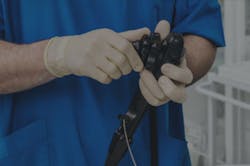In pursuit of the perfectly processed device
With the unfortunate recent outbreaks of infections tied to ineffectively reprocessed flexible endoscopes, the intensity of interest in methods and means to determine if these devices are safe to use, has grown exponentially.
Since 2005, products have been available in the North American market to test the cleanliness of flexible endoscopes after cleaning. While there was interest, it is no exaggeration to say the interest has exploded over the last two 2 years. In this time, there has been renewed consideration of testing flexible endoscopes for viable bacterial contamination as well. This has set up a perceived dichotomy and confusion as healthcare professionals weigh their options for ongoing surveillance testing of flexible endoscopes: “Do we test for cleaning?” “Do we test for microbial contamination?”
My answer to this dichotomy is: “Yes!”
Let me explain why.
Medical device manufacturers (MDMs), when conducting their validation testing for the recommended reprocessing instructions for their devices, follow the Food and Drug Administration (FDA) guidance that cleaning validation testing be conducted independent of disinfection/sterilization (the terminal process) validation testing. Why? The objective of each stage of reprocessing is different. Cleaning is the removal of contaminants. Disinfection/sterilization is the destruction of viable microbial agents. Each stage plays a major role in rendering the device safe and ready for use on the next patient.
The goal of cleaning is to remove organic and other soils from a clinically used device to the point that the contaminants will:
- not interfere with the efficacy of the terminal process;
- not pose an anaphylactic threat to the next patient;
- be safe to handle with bare hands by reprocessing staff as they prepare the device for the terminal process.
The FDA asks that the MDM supply scientific evidence from testing that the device is indeed clean after the cleaning steps specified in the device’s instruction for use (IFU).
Further, the FDA says that this evidence must include at least two markers that are clinically relevant. What is a clinically relevant marker? A soil that the device is likely to be contaminated with during use on the patient. Protein is a very commonly used marker. Other markers may include total organic carbon (TOC), hemoglobin or carbohydrates. These markers are often chosen because they are just the kind of soils likely to come from the patient during the procedure. So when demonstrating that the device is clean, the MDM is testing for any residual of the given marker to determine if any remains below a defined acceptance criterion (that must be identified and justified by the MDM as well).
When it comes to validation of the terminal process (disinfection or sterilization), this testing must be done completely independent of the cleaning validation. The device needs to be inoculated with an organism or organisms that represent a significant challenge to the terminal process. Typically, the organism is well identified for the given modality (i.e., Geobacillus stearothermophilus for steam sterilization). The MDM is responsible for identifying the areas of the device that should be inoculated (based upon worst case conditions).
The volume of the organism is typically defined (6-log if half-cycle testing). It may also be reasonable to include some organic soiling that would provide a further challenge – not at the level of cleaning validation testing, but a level that would be considered worst case after cleaning. After going through the terminal process, samples from the inoculated areas are taken and the those samples are cultured for any microbial growth. Depending upon the modality of sterilization, such as steam sterilization, it is anticipated that any culturing would be negative for growth.
So back to the dichotomous questions: Do we test for cleaning? Do we test for microbial growth? My answer remains: “Yes!” That is what the MDM did to validate their reprocessing instructions. Isn’t that what the healthcare facility should do to verify that their reprocessing was effective?
Let’s step out of the GI Clinic and go into the Sterile Processing Department (SPD) of the hospital. What testing are they doing to verify that their processes are effective?
Well, after cleaning, they are using cleaning verification tests to determine if their equipment is working properly (e.g., test coupons), and to determine if their instruments are free of organic contaminants (protein, hemoglobin, ATP, etc.), then they prepare the instrument for the terminal process – typically packaging it inside a basket or container in such a way that sterility will be maintained after the terminal process.
Part of that, particularly with implants, involves the use of biological indicators. They place the instruments inside the sterile barrier system, and include chemical sterilization indicators. They may also place a PCD that includes a biological indicator inside the sterilizer to challenge the load. What’s in the biological indicator? Probably the same organism that was used by the MDM in their sterilization validation testing. At the end of the cycle, the biological indicator goes into an incubator, and after the prescribed period of time, the SPD staff checks to see if there was any indication of growth. If the answer is no, all is good.
So, back to the dichotomous questions: Do we test for cleaning? Do we test for microbial growth? My answer is again, “Yes!” This is what we do in SPD with surgical instruments. Why would we do anything different when it comes to flexible endoscopes?
Having said “Yes,” I also know that this is not considered practical at many facilities today. So the follow-up question often comes: “I don’t think we can do both. If we can only do one, which one should we do?”
Well, I have a couple of answers. First, while I believe both should be done, the next question is, “how often?” A practical compromise would be to do the less burdensome testing more frequently, and the more burdensome testing less frequently. Cleaning verification tests today are typically easier to perform and provide a much more rapid result, than microbial contamination testing. So test for cleaning more frequently.
“But really, we can only do one. Which one should we do?” I think if you queried an epidemiologist, a medical doctor and even many infection control professionals, their advice would be something like this: “Well, the ultimate goal is to destroy infectious agents, so let’s test for those.”
I understand this thinking, but I believe it is wrong. Why? A couple of reasons. First, organic soils themselves (blood, etc.) can be of danger to the next patient. Second, is much simpler: Remember one of key goals of cleaning is to reduce bioburden to a level that it will not interfere with the terminal process. If you do not get the device clean, your chance of getting it disinfected/sterile are greatly diminished.
So I have answered the not-so-dichotomous questions.
But what about this “pursuit of the perfect?”
Verification testing is all about the pursuit of the perfect – a perfectly safe device that is ready to be used on the next patient. But is perfection possible? I raise this issue because I think it is very important to understand the efficacy of verification testing (be it for cleaning or microbial contamination). When the MDM is doing their validation testing, this testing is performed in laboratory conditions. The test protocol will specify the nature of the contamination, the location and volume of the contamination and the method(s) that will be used to extract samples (that may include destruction of the device) and detect the contaminant(s).
When we get into the real world – the verification world, if you will – these knowns become unknowns. We don’t know for sure the composition of the residual contaminants, or even if any remains. We do not know the location of the contamination, if any even remains. We certainly do not know the volume. The IFU for the verification test method tells us how to extract based upon what is practical and proven effective without damaging the device, but is not necessarily effective for the instrument that is in your hand. Finally, and this is a key point, particularly with flexible endoscopes – if it was easy to extract a sample for verification testing, it would be easy to clean the device. In other words, since flexible endoscopes have proven a challenge to clean, they are also challenge to capture a sample for verification testing – and for the same reasons.
So now you may ask, “what is the point of verification testing, if it can’t reliably tell us if the flexible endoscope in my hand is safe to use?” My answer? That is why it is so important to test and test as frequently and comprehensibly as you can. Why do I say that?
Well let’s say that verification testing (be it for organic soils, or microbial organisms) only flags positive when contamination is present 50 percent of the time. If I test a scope once per month, then it may take me two months (maybe more) before I identify a possible problem. If I test weekly, it might take two weeks. If I test daily, I probably will identify an issue in a matter of a couple of days. If I test every scope every time it is used, it may only be a couple of uses before I identify an issue. If I test both for organic soil(s) and microbial contamination, I have an even better chance of identifying a problem with the process because I am employing more than one test method.
Today, medical facilities are faced with a balancing act: What to use and the how often. Some elect not to do anything until it is mandated. Others are the early adopters and are implementing monitoring programs now. Regardless, no facility wants to be the next “headlines.”
I am reminded of a saying: “Don’t let the perfect be the enemy of the good.” Verification testing cannot be perfect because of all the unknowns. But it can be effective. By implementing a routine monitoring program that is as comprehensive and as frequent as your facility can manage, by the sheer repetition of testing, you will identify shortcomings with your process, identify areas for needed improvement, and help to ensure the reprocessing process is indeed producing flexible endoscopes that are clean, disinfected and safe to use on the next patient.

